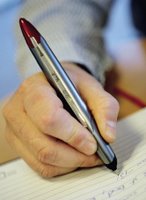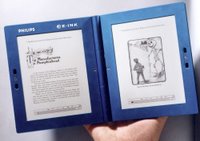Digital paper has been a subject of research since the 1990s. Several approaches have been made: a real hybrid approach and a look alike one.
 The hybrid approach has been made by Anoto, a Swedish company. In principle it involves paper, pre-printed with thousand of tiny, nearly invisible spots. The accompanying big pen equipped with a pressure sensor, a digital camera and a Bluetooth transceiver. This Bluetooth component can send the writing to a Bluetooth equipped PC or to a mobile phone for the text or drawing to be e-mailed. This system is now out of the laboratory and is being used by some logistics companies such as TPG. So far the system has made no inroads in printing.
The hybrid approach has been made by Anoto, a Swedish company. In principle it involves paper, pre-printed with thousand of tiny, nearly invisible spots. The accompanying big pen equipped with a pressure sensor, a digital camera and a Bluetooth transceiver. This Bluetooth component can send the writing to a Bluetooth equipped PC or to a mobile phone for the text or drawing to be e-mailed. This system is now out of the laboratory and is being used by some logistics companies such as TPG. So far the system has made no inroads in printing.The look-alike approach was taken by American companies. Xerox developed digital paper, named Gyricon, based on ink, encapsulated in plastic, which can be transformed to letters with electric pulses. By December 2005 Gyricon Media ended its operations; however Xerox will refocus its efforts in electronic paper technology through licensing of the underlying intellectual property. A refinement on the Xerox approach has been taken by E-Ink, which puts small capsules on a substrate and can change the letters with electric pulses. Philips bought itself into E-Ink and has started a development of its own. It is now industrially producing digital paper with a white background and 12 grey tones. The readability of the screen has improved dramatically, so that the text can be read in the sun without any problem. For the time being it is black and white; colours are planned for 2007/2008. And as the rate of change of the electronic ink is still slow, no video can be presented on it yet. In principle the digital paper is flexible and rollable. (look at the Philips videos on rollable display: Long version of 2.26 min. or the Short version (1.25 min.)
 The principle of the digital paper rest on the substrate and the ink. The 3-inch wide display screen has become flexible by developing a stainless steel foil topped with a thin layer of circuits that control an overlying film of electronic ink. The ink contains tiny capsules with black and white particles with opposing electrical charges floating in a clear fluid. When a negative voltage is run through circuits behind these capsules, the positive white particles move to the capsule's top. A positive current does the same to the negative black particles. The resolution of the prototype is 96 pixels per inch and it is a total of 160 by 240 pixels in size. The display can be refreshed in 250 milliseconds, too slow to display video, but fast enough to support something like a constantly updating electronic paper by a wireless connection. The human eye blends the presented patterns of black- or white-topped capsules into text displayed in a traditional column.
The principle of the digital paper rest on the substrate and the ink. The 3-inch wide display screen has become flexible by developing a stainless steel foil topped with a thin layer of circuits that control an overlying film of electronic ink. The ink contains tiny capsules with black and white particles with opposing electrical charges floating in a clear fluid. When a negative voltage is run through circuits behind these capsules, the positive white particles move to the capsule's top. A positive current does the same to the negative black particles. The resolution of the prototype is 96 pixels per inch and it is a total of 160 by 240 pixels in size. The display can be refreshed in 250 milliseconds, too slow to display video, but fast enough to support something like a constantly updating electronic paper by a wireless connection. The human eye blends the presented patterns of black- or white-topped capsules into text displayed in a traditional column.But it is not only Philips who is producing digital paper through commercial and business spin-offs in Europe and China. Also Sony is following the E-Ink development and using digital paper for its e-book. For the time being the E-Ink development of digital, flexible and rollable paper looks to be a winner.
 Other digital paper developments are taking place in laboratories of Fujitsu Laboratories and Siemens. Fujitsu Laboratories has successfully made a prototype electronic paper which is comparable to regular copy paper in brightness and thickness. Fujitsu hopes to have the paper in regular production by 2006.Several characteristics of the paper have been developed; ease of reading, ease of portability, durability and improved brightness and contrast of the paper. The new developments have made the electronic paper with a white ratio of 80 or above and a contrast ratio of 15 or above. When compared with regular photo-copy paper there is very little difference. When the power is turned on and off with colour and text being added to the paper, and then subsequently turned off, the paper still retains the material that was written on it using a built-in memory function. The power function of the electronic paper is a special energy saving device suited for this application. The paper will be easy to use, have almost unlimited rewriting capabilities, freedom of deformation and portability. Fujitsu hopes that this invention will contribute to the paperless office and reduce the amount of paper consumption in the world.
Other digital paper developments are taking place in laboratories of Fujitsu Laboratories and Siemens. Fujitsu Laboratories has successfully made a prototype electronic paper which is comparable to regular copy paper in brightness and thickness. Fujitsu hopes to have the paper in regular production by 2006.Several characteristics of the paper have been developed; ease of reading, ease of portability, durability and improved brightness and contrast of the paper. The new developments have made the electronic paper with a white ratio of 80 or above and a contrast ratio of 15 or above. When compared with regular photo-copy paper there is very little difference. When the power is turned on and off with colour and text being added to the paper, and then subsequently turned off, the paper still retains the material that was written on it using a built-in memory function. The power function of the electronic paper is a special energy saving device suited for this application. The paper will be easy to use, have almost unlimited rewriting capabilities, freedom of deformation and portability. Fujitsu hopes that this invention will contribute to the paperless office and reduce the amount of paper consumption in the world. Siemens has taken a wide approach to the development of the new screens. The technology makes it possible to put moving images directly onto paper, at a cost that would make it economical to use on everything from newspapers, magazines to cigarette packets. The moving images would give more detailed instructions than any photo could ever do. One square metre of the material will cost around £30; the screens should be available by 2007.
Siemens has taken a wide approach to the development of the new screens. The technology makes it possible to put moving images directly onto paper, at a cost that would make it economical to use on everything from newspapers, magazines to cigarette packets. The moving images would give more detailed instructions than any photo could ever do. One square metre of the material will cost around £30; the screens should be available by 2007.So far Philips spin-offs have been able to manufacture digital paper under industrial circumstances. the digital paper prototypes of Fujitsu and Siemens are still in the laboratory phase.
Tags: Books, digital paper
Blog Posting Number: 445

No comments:
Post a Comment